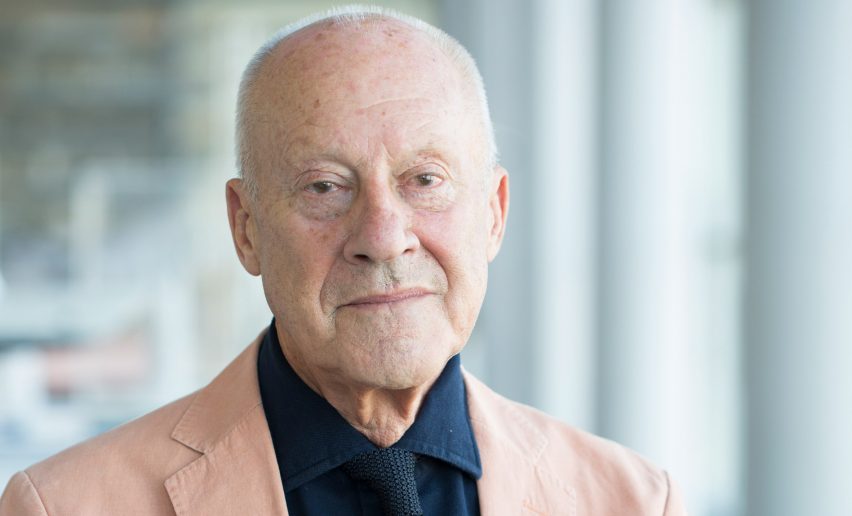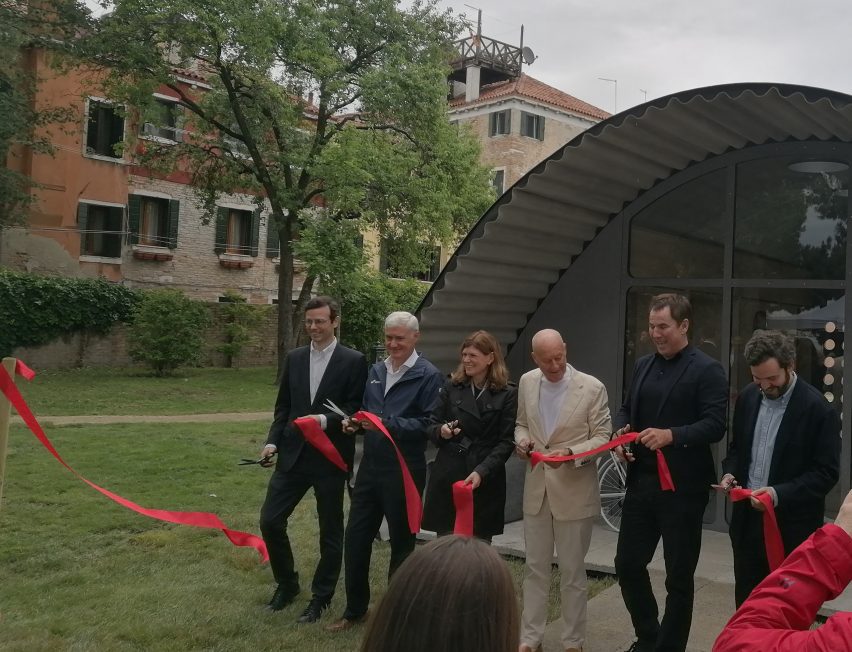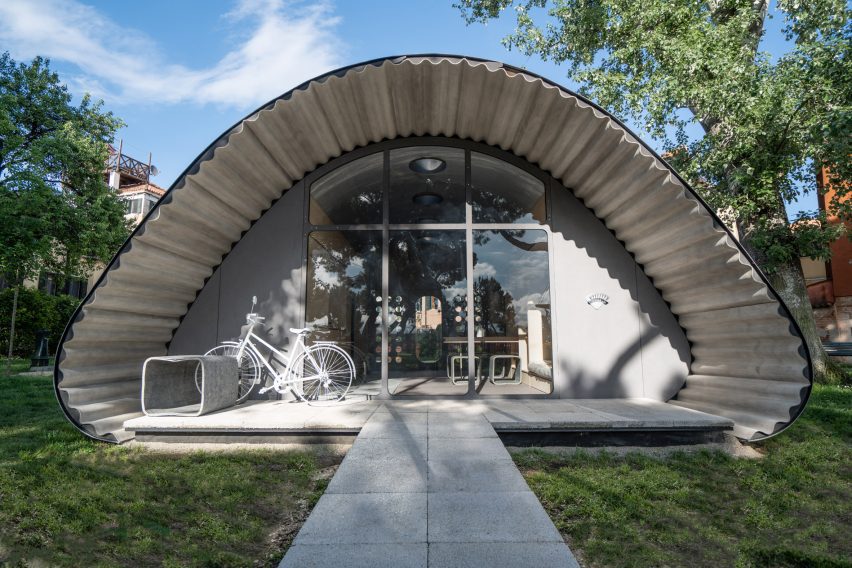
"Architecture without architects" can teach valuable lessons says Norman Foster
The simplest of structures, such as tents and huts, can teach architects lessons, British architect Norman Foster said in an exclusive interview at the Venice Architecture Biennale.
Speaking to Dezeen at the Ca'di Dio hotel in Venice, Foster said that basic buildings that are created without architects, constructed with local materials and with passive design strategies can all serve as valuable reference points for the industry.
"As a student, I was fascinated by what would now be called the vernacular and studied buildings that were not considered architecture in a school of architecture, like barns and windmills," Foster explained.
"I think that there are lessons from what is called 'architecture without architects', where people have created a response using local materials, working with nature, creating environments in a desert before the age of cheap energy by passive cooling, thermal mass and so on," he continued.
"I think that those are our valuable lessons."
It was an examination of these kinds of structures that led to the Essential Houses Research Project – a housing concept he launched yesterday at the Venice Architecture Biennale.

Designed as part of the Norman Foster Foundation with building materials company Holcim, the project is aimed at improving the living conditions of people displaced by natural and manmade disasters.
It focuses specifically on improving the kind of shelter provided by traditional tents that typically define temporary settlements while retaining their simplicity, affordability and ease of construction.
Project team forced to go "back to basics"
The project began in June 2022 at the foundation's Shelters Workshop, where students were invited to go "back to basics" and develop solutions for emergency shelters over five days.
"You can't think of anything more extreme than how you create an instant dwelling, and, obviously, the tent is an immediate response to that," Foster said.
"Challenging and trying to do something which is more durable than a tent, but has to be ultra economic and has to be realised by unskilled labour, and you're only allowed the luxury of days to do it, that concentrates the mind and I think it brings you back to basics."
The Essential Homes Research Project exhibit at the Biennale includes a full-scale prototype in Giardini della Marinaressa, supported by an exhibition at Palazzo Mora.
The exhibition outlines how the structures can be built in just three to four days and, while serving displaced communities, they can also be used as an affordable housing model.
"We should be doing more"
Foster believes that the architecture industry has a huge potential when it comes to developing these kinds of philanthropic projects and that it should be doing more of them.
"I think the profession has a huge amount to offer," he explained. "I think it's a profession that is well equipped to make a contribution," he continued.
"Of course, you can always do better, you can always do more, whether it's an individual, whether it's a collective, whether it's a practice, a partnership, an enterprise, or a profession. And I think that we should be doing more."

However, he also acknowledged that personal priorities and commercial realities are often a barrier to this.
"The foundation is able to do what a practice by virtue of its commercial reality can't," he said.
"In other words, any practice, whatever it says, if it continues in practice unless it's got a private income, it has to be able to pay the people who work for it."
He said that this is "perhaps why there is absolutely no link" between his studio and the foundation.
"It's in the nature of a foundation that it can address those issues, which in the commercial world, there's no there's no circumstance that could enable you to address that."
"It's just the beginning"
The Essential Homes Research Project was made possible with sponsorship from collaborator Holcim. According to the company's CEO Jan Jenisch, businesses like Holcim also have a part to play in developing these kinds of humanitarian projects.
"We're the largest building materials company in the world, so we have the duty to support human humanitarian projects," Jenisch told Dezeen.
"It's just the beginning, we're fully committed," he said. "We are also happy to sponsor some communities because we want to see this in reality. We cannot leave it as a prototype, that's not good enough."
While supporting these endeavours, Jenisch explained how they can also be used to trial and develop new and innovative products that can be scaled up and help to advance architecture.
For example, in the case of this project, Jenisch hopes that the shelter's unusual roof structure could become a replicable low-carbon product.
The roof of the shelter is created from a rollable canvas containing Holcim's own low-carbon cement mix, which is draped over an arch-shaped formwork. After being sprayed with water, this canvas dries and hardens to form a solid shell.
"It's quite a smart roof," he continued. "While we will not intend to make any profit with these projects, that's a product we could imagine for other applications."
Biennale is "a reflection of the individuals who steer it"
According to Foster, presenting the Essential Homes Research Project at the Venice Architecture Biennale was a motivation for the project, encouraging its rapid nine-month development.
"The workshop was successful to the point that everybody who was involved with it felt, how can we bring some of these ideas to reality? How can we push the boundaries, how can we test it out? We need an opportunity. We need an excuse. And nothing works better than a deadline," he said.
"The Venice Architecture Biennale, where there are enough outlets for experimental projects, it became a goal, it became a deadline," he continued. "If we hadn't had that deadline, I don't think we would have ever got to the point where we've got to."
The Essential Homes Research project is the second collaboration presented by the Norman Foster Foundation and Holcim at the Venice Architecture Biennale, following their collaboration in 2016 on Droneport – a full-scale prototype of a hangar for drones for the distribution of medical supplies in Africa.
While Foster was yet to visit this year's Venice Architecture Biennale when Dezeen spoke to him, he said he expects it to be a reflection of its curator Lesley Lokko.
"[Venice Architecture Biennale] is very much a reflection of the individuals who steer it", Norman Foster told Dezeen. "It's a combination of who's behind it, behind the scenes here in Venice, and the curators who are invited."
"I think the curators in the past, they've all had the individual points of emphasis. So one curator has an interest in the city, another curator has an interest in issues of materials, another curator sees the role of history as important," he continued.
He said he was also told to expect that "this is a different Biennale" to previous years.
"I was just saying at the end of the conference [yesterday] in the [Hotel] Monaco, ‘what should I see here?' and somebody was saying this is a different Biennale,” he continued.
"You'll see the architecture of the Arsenale, there's less interruption, it's more about the fabric of the of the buildings."
Follow the live coverage on Dezeen live: Venice Architecture Biennale. The Venice Architecture Biennale takes place from 20 May to 26 November 2023. See Dezeen Events Guide for all the latest information you need to know to attend the event, as well as a list of other architecture and design events taking place around the world. All times are Venice time.